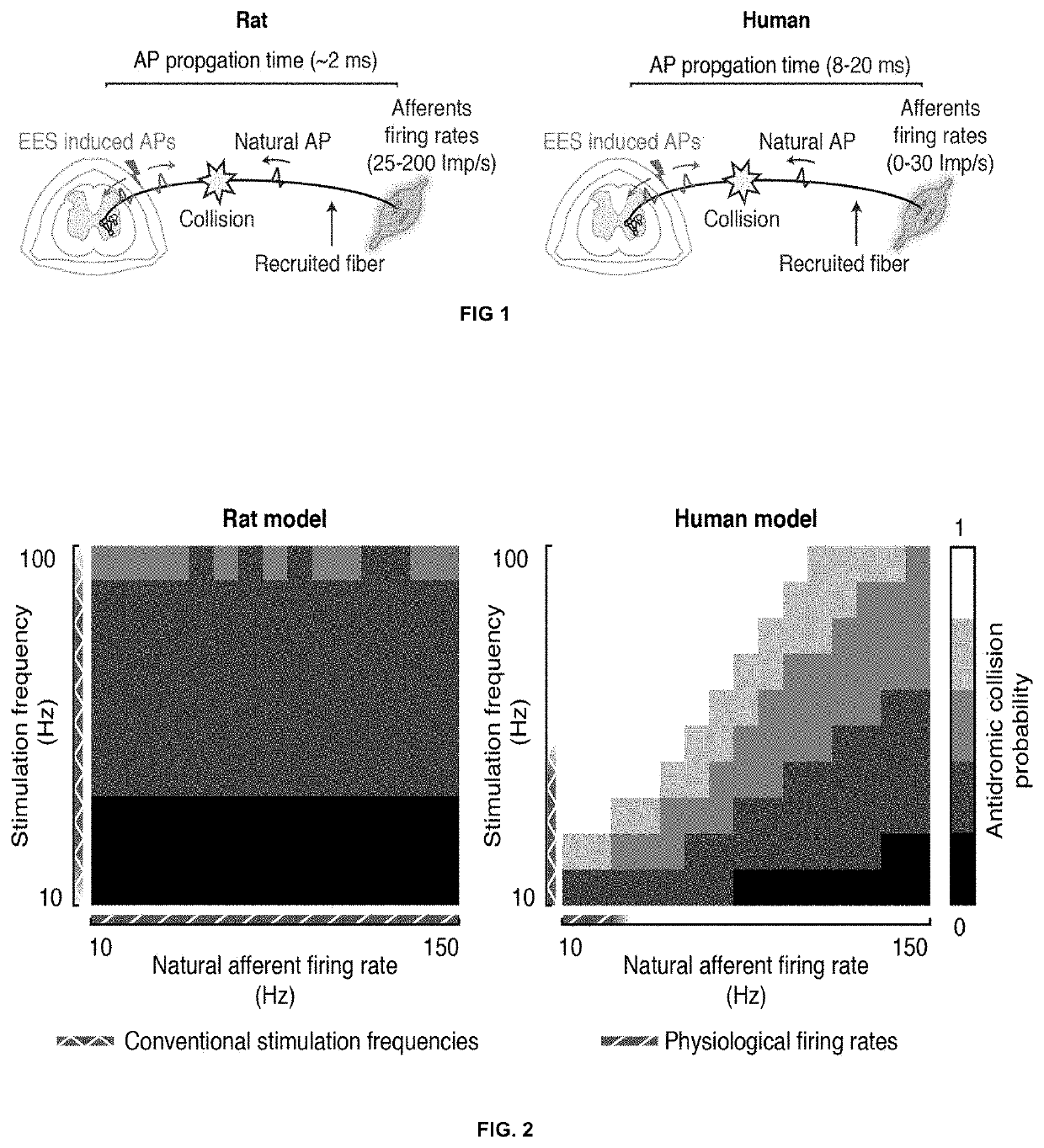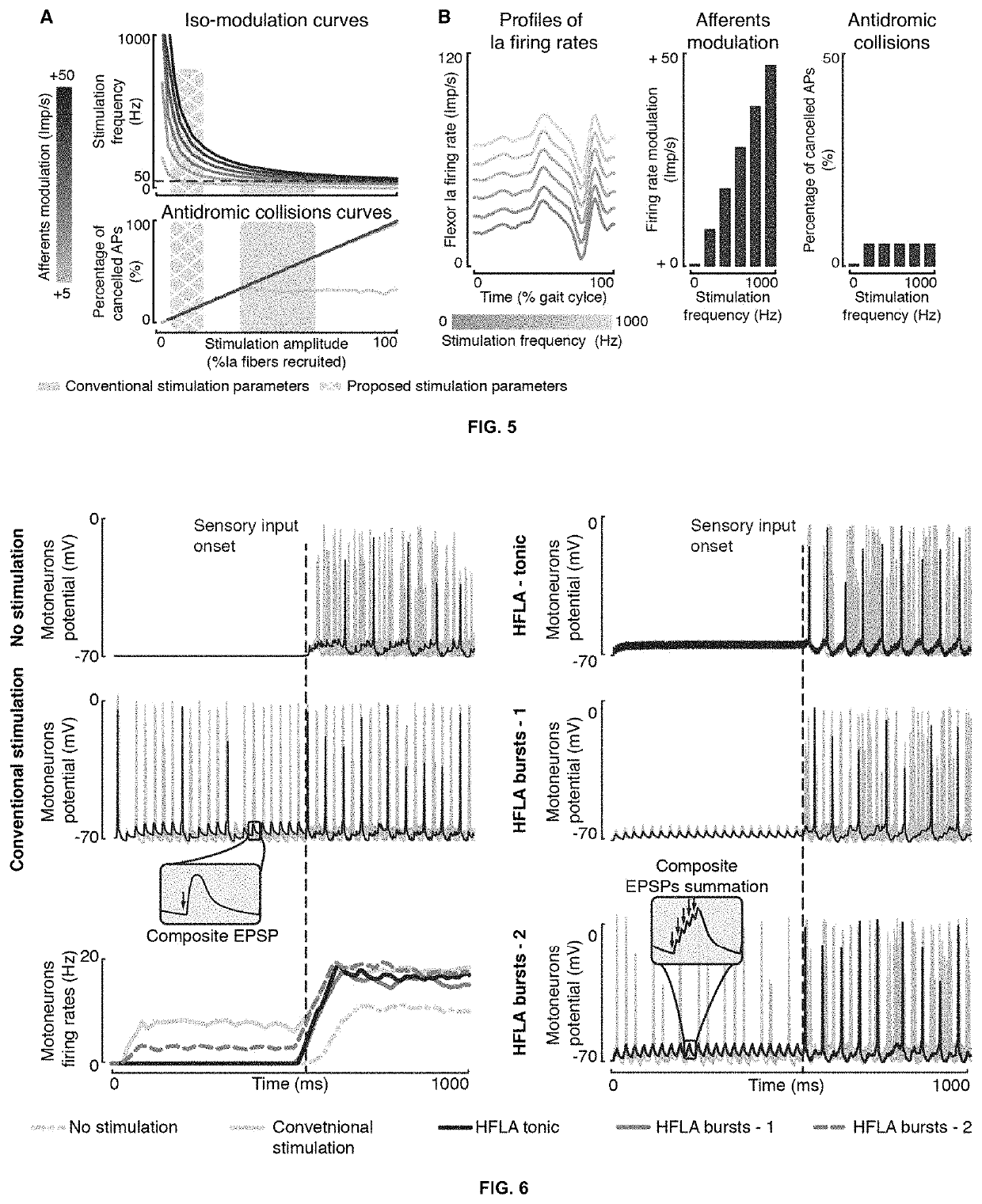A sensory information compliant spinal cord stimulation system for the rehabilitation of motor functions
a sensory information and spinal cord stimulation technology, applied in the field of spinal cord neuroprosthesis, can solve the problems of limiting human translation, disrupting the communication between supraspinal centers and spinal circuits, and reducing so as to improve the recovery of motor functions and increase spinal excitability
- Summary
- Abstract
- Description
- Claims
- Application Information
AI Technical Summary
Benefits of technology
Problems solved by technology
Method used
Image
Examples
example 1
Assessment of Destructive Interference in Human Spinal Cord Stimulation
[0197]Every pulse of electrical spinal cord stimulation elicits action potentials in the recruited fibers that propagate both orthodromically (i.e., running along the axon in its natural, normal direction) and antidromically (in the opposite direction). For the duration of the traveling time of an antidromic action potential toward the periphery, orthodromic activity in the same axon generated naturally in the periphery during the movements will be eliminated, a phenomenon known as antidromic collision. For this reason, part of the natural sensory information flowing into the spinal cord during movement execution could collide with antidromic action potentials elicited along the nerve by the stimulation, and thus being cancelled by the stimulation. We hereafter term this interaction of the electrical stimulation with the sensory feedback information as destructive interference.
[0198]The occurrence probability of ...
example 2
Comparison Between Stimulation Paradigm According to the Invention and Conventional Stimulation Protocols
[0203]Conventional spinal cord stimulation protocols for promoting walking function, derived from animal models, use frequencies ranging from 20 to 50 Hz (Angeli et al., 2014; Danner et al., 2015) and amplitudes sufficient to induce leg muscle activation with each stimulation pulse. As we showed before, with these stimulation frequencies the sensory information in the electrically recruited fibers collides with the induced antidromic activity. Considering that to elicit a motor response through reflex circuits, approximately 40% of the Ia fibers need to be recruited, it is clear that these type of stimulation protocols drastically reduces the amount of sensory feedback information actually reaching the spinal cord. This sensory information is thought to be the source of motor control necessary to drive the recovery of locomotion. For this reason, we hypothesize that a stimulation...
example 3
Effects of High-Frequency SCS in Rodents
[0213]The disclosed stimulation paradigm relies on two independent mechanisms.
[0214]First, every Ia fiber has excitatory synaptic connections with all the motoneurons of the homonymous muscle. For this reason, even the recruitment of few fibers would convey excitation to the whole motor pool.
[0215]Second, excitatory post synaptic potentials (EPSPs) induced by the Ia fibers on the motoneurons are characterized by a duration at half amplitude of approximately 4 ms (Burke R. E, 1968). This suggests that the recruitment of few afferent fibers at high frequency would elicit strong depolarizations in the motoneurons because consecutive EPSPs will summate over time.
[0216]However, the maximum rate of EPSPs summation depends on the refractory period of the afferents that could be too long to allow for effective depolarization of the motoneurons. Moreover fast repetitive recruitment of Ia fibers would lead to homosynaptic depression of the synaptic term...
PUM
 Login to View More
Login to View More Abstract
Description
Claims
Application Information
 Login to View More
Login to View More - R&D
- Intellectual Property
- Life Sciences
- Materials
- Tech Scout
- Unparalleled Data Quality
- Higher Quality Content
- 60% Fewer Hallucinations
Browse by: Latest US Patents, China's latest patents, Technical Efficacy Thesaurus, Application Domain, Technology Topic, Popular Technical Reports.
© 2025 PatSnap. All rights reserved.Legal|Privacy policy|Modern Slavery Act Transparency Statement|Sitemap|About US| Contact US: help@patsnap.com



